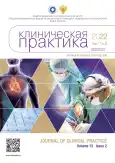Shortening of the PR interval in pericarditis after coronary bypass surgery
- Authors: Dundua D.P.1, Khabazov R.R.2, Hricheva N.A.3
-
Affiliations:
- Federal Scientific and Clinical Center for Specialized Medical Assistance and Medical Technologies of the Federal Medical Biological Agency
- Sechenov First Moscow State Medical University (Sechenov University)
- Multifunctional medical center MEDSI
- Issue: Vol 13, No 2 (2022)
- Pages: 5-11
- Section: Original Study Articles
- URL: https://journals.rcsi.science/clinpractice/article/view/108032
- DOI: https://doi.org/10.17816/clinpract108032
- ID: 108032
Cite item
Full Text
Abstract
Background: Pericarditis, following pericardiotomy, is a well-known complication of cardiac surgery. The diagnosis of postpericardiotomy pericarditis (PP) is based on the electrocardiography (ECG) changes — the ST segment elevation in combination with a depression of the PR interval. However, in some cases, the ECG changes are difficult to distinguish from the changes associated with ST segment elevation acute coronary syndrome. In such cases, the diagnosis of pericarditis is made by excluding acute coronary syndrome, for which additional expensive diagnostic tests are performed. Aims: the purpose of the study is to identify a pattern in the change in the PR interval, which is detected in patients with acute pericarditis who underwent pericardiotomy during coronary bypass surgery. Methods: The observational study included 47 patients after coronary bypass surgery. We compared ECG of two groups of patients after coronary artery bypass grafting — 25 patients who demonstrated the ECG signs of acute pericarditis and 22 patients without those. Results: In most patients with PP after coronary bypass surgery, the characteristic ECG signs of acute pericarditis were accompanied by a transient shortening of the PR interval by 0.04 sec. Conclusion: The absence of such dynamics in patients after coronary artery bypass grafting without the ECG signs of pericarditis may indicate that a transient shortening of the PR interval may be an additional easily available ECG sign of acute PP.
Full Text
##article.viewOnOriginalSite##About the authors
David P. Dundua
Federal Scientific and Clinical Center for Specialized Medical Assistance and Medical Technologies of the Federal Medical Biological Agency
Email: david.doundoua@gmail.com
ORCID iD: 0000-0001-7345-0385
MD, PhD, Professor
Russian Federation, MoscowRobert R. Khabazov
Sechenov First Moscow State Medical University (Sechenov University)
Author for correspondence.
Email: roba.khabazov@mail.ru
ORCID iD: 0000-0002-7855-6354
Student
Russian Federation, MoscowNataly A. Hricheva
Multifunctional medical center MEDSI
Email: hricheva@icloud.com
ORCID iD: 0000-0003-1489-9670
MD
Russian Federation, MoscowReferences
- Imazio M, Gaita F, LeWinter M. Evaluation and treatment of pericarditis: a systematic review. JAMA. 2015;314(14):1498–506. doi: 10.1001/jama.2015.12763
- Chiabrando JG, Bonaventura A, Vecchié A, et al. Management of acute and recurrent pericarditis: JACC state-of-the-art review. J Am Coll Cardiol. 2020;75(1):76–92. doi: 10.1016/j.jacc.2019.11.021
- Kytö V, Sipilä J, Rautava P. Clinical profile and influences on outcomes in patients hospitalized for acute pericarditis. Circulation. 2014;130(18):1601–1606. doi: 10.1161/CIRCULATIONAHA.114.010376
- Spodick DH. Pericardial rub. Prospective, Multiple observer investigation of pericardial friction in 100 patients. Am J Cardiol. 1975;35(3):357–362. doi: 10.1016/0002-9149(75)90027-2
- Chou TC. Electrocardiography in clinical practice. WB Saunders Company, Philadelphia; 1996. 729 р.
- Spodick DH. Differential characteristics of the electrocardiogram in early repolarization and acute pericarditis. N Engl J Med. 1976;295(10):523–526. doi: 10.1056/NEJM197609022951002
- Chen JC, Kaul P, Levy JH, et al. Myocardial infarction following coronary artery bypass graft surgery increases healthcare resource utilization. Crit Care Med. 2007;35(5):1296–1301. doi: 10.1097/01.CCM.0000262403.08546.A2
- Nalysnik L, Fahrbach K, Reyniolds MW, et al. Adverse events in coronary artery bypass graft (CABG) trials: a systematic review and analysis. Heart. 2003;89(7):767–772. doi: 10.1136/heart.89.7.767
- Cheitlin MD, Armstrong WF, Aurigemma GP, et al. ACC/AHA/ASE 2003 guideline for the clinical application of echocardiography: summary article: a report of the American College of Cardiology/American Heart Association Task Force on Practice Guidelines (ACC/AHA/ASE Committee to Update the 1997 Guidelines for the Clinical Application of Echocardiography) Circulation. 2003;108(9):1146–1162. doi: 10.1161/01.CIR.0000073597.57414.A9
- Permanyer-Miralda G, Sagristá-Sauleda J, Soler-Soler J. Primary acute pericadial disease: a prospective series of 231 consecutive patients. Am J Cardiol. 1985;56(10):623–630. doi: 10.1016/0002-9149(85)91023-9
- Imazio M, Demichelis B, Cecchi E, et al. Cardiac troponin I in acute pericarditis. J Am Coll Cardiol. 2003;42(12):2144–2148. doi: 10.1016/j.jacc.2003.02.001
Supplementary files








